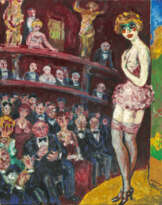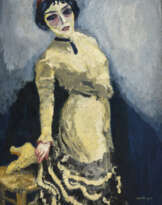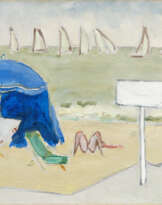ID 832295
Lot 128 | Kees van Dongen (1877-1968)
Estimate value
€ 150 000 – 250 000
Portrait de jeune femme
signé 'van Dongen" (le long du bord droit)
huile sur toile
55.1 x 32.2 cm.
Peint vers 1930
signed 'van Dongen' (along the right edge)
oil on canvas
21 3/4 x 12 5/8 in.
Painted circa 1930
Provenance
Collection particulière, France (en 1958-59).
Puis par descendance au propriétaire actuel.
Special Notice
Artist's Resale Right ("droit de Suite").
If the Artist's Resale Right Regulations 2006 apply to this lot, the buyer also agrees to pay us an amount equal to the resale royalty provided for in those Regulations, and we undertake to the buyer to pay such amount to the artist's collection agent.
Post Lot Text
« Dès qu’une femme se met un peu de poudre, la peinture commence et il y a un artiste »
Kees van Dongen
“The instant a woman applies a little powder, the painting begins and an artist emerges”
Kees van Dongen
Reconnu pour ses talents de portraitiste, le peintre hollandais Kees van Dongen parvient rapidement à capturer l’essence d’une nouvelle génération de femmes . Suite à son installation en France et sa rencontre avec la créatrice de mode Léa (Jasmy) Jacob, l’artiste découvre l’élite parisienne. Ses nombreux portraits, notamment de figures féminines, connaissent rapidement un succès auprès de la belle société ainsi qu’une reconnaissance critique. Dès 1920, Gustave Coquiot écrivait ainsi qu’avec ses portraits, van Dongen « déclare vouloir exprimer dans ses images le tempérament de la femme moderne et, à travers elle, l’esprit de son temps » (G. Coquiot cité in Van Dongen, Fauve, anarchiste et mondain, cat. exp., Musée d’art moderne de la ville de Paris, Paris, 2011, p. 189.) Cela s’applique particulièrement à ce Portrait de jeune femme dans lequel l’artiste représente une femme aux cheveux courts, au maquillage prononcé et au long cou dégagé. Ses grands yeux plus grand que la bouche, emblématique de la touche particulière de l'artiste et souvent critiquée par ses contemporains, sont néanmoins assumés par van Dongen : ils exaltent, selon lui, la figure féminine, note d'ailleurs Jean Melas Kyriazi : « Pour un bon peintre, il n’est peut-être pas difficile d’exécuter un portrait ressemblant, mais il n’en va pas de même lorsqu’il s’agit de faire ressortir l’individualité, le caractère ou le manque de caractère, bref tout ce qui caractérise le modèle, qui pose dans l’immobilité et le silence » (J. Melas Kyriazi, Van Dongen Après le Fauvisme, Lausanne, 1987, p. 50). Toujours selon Jean Melas Kyriazi, l’ « artiste s’y révèle un excellent psychologue, à qui rien n’échappe, et il parvient à mettre à nu le cœur de ces clients » (ibidem). C’est bien cela qui permet à Kees van Dongen d’échapper à « cette vaste catégorie des portraitistes voués à un oubli certain : la postérité se référera à ses portraits pour juger les années folles » (ibid., p. 57). Ainsi, le présent Portrait de jeune femme parvient-il à la fois de rendre compte l’âme de son modèle, mais également celle de toute une époque et d’un artiste, Kees van Dongen.
Recognised for his abilities as a portrait artist, Dutch painter Kees van Dongen was quick to capture the essence of a new generation of modern women. After moving to France and meeting fashion designer Léa (Jasmy) Jacob, the artist discovered the luxurious world of the Paris elite. His many portraits, especially of women, were lauded in fashionable society and achieved critical acclaim. As early as 1920, Gustave Coquiot wrote that, through his portraits, van Dongen “is stating his desire to express in his images the temperament of the modern woman and, through her, the spirit of our times” (G. Coquiot quoted in Van Dongen, Fauve, anarchiste et mondain, exp. cat., Musée d’art moderne de la ville de Paris, Paris, 2011, p. 189). This is particularly true of Portrait de jeune femme in which the artist has depicted a woman with short hair, prominent make-up and a long, exposed neck. Her eyes are larger than her mouth ‒ a hallmark of the artist often criticised by his contemporaries but one defended by van Dongen as glorifying, in his view, the female figure. As Jean Melas Kyriazi notes : “To be a good painter, it isn’t perhaps hard to paint a portrait that is a good likeness, but it’s a different story when it comes to getting across a person’s individuality, their character or lack of it - in short, everything about the model who posed for him without moving or making a sound” (J. Melas Kyriazi, Van Dongen Après le Fauvisme, Lausanne, 1987, p. 50). Jean Melas Kyriazi also wrote that, “here the artist reveals himself to be a keen psychologist, nothing escapes him, he sees right into the heart of these clients” (ibidem). This sets Kees Van Dongen apart from “the broad class of portrait painters who are doomed to a certain oblivion: posterity will look to his portraits to form an opinion on the Roaring Twenties” (ibid., p. 57). The Portrait de jeune femme manages to capture the soul of his model, an entire epoque, and an artist, Kees van Dongen.
| Artist: | Kees van Dongen (1877 - 1968) |
|---|---|
| Applied technique: | Oil on canvas |
| Auction house category: | Paintings |
| Artist: | Kees van Dongen (1877 - 1968) |
|---|---|
| Applied technique: | Oil on canvas |
| Auction house category: | Paintings |
| Address of auction |
CHRISTIE'S 9 Avenue Matignon 75008 Paris France | ||||||||||||||
|---|---|---|---|---|---|---|---|---|---|---|---|---|---|---|---|
| Preview |
| ||||||||||||||
| Phone | +33 (0)1 40 76 85 85 | ||||||||||||||
| Fax | +33 (0)1 40 76 85 86 | ||||||||||||||
| Conditions of purchase | Conditions of purchase | ||||||||||||||
| Shipping |
Postal service Courier service pickup by yourself | ||||||||||||||
| Payment methods |
Wire Transfer | ||||||||||||||
| Business hours | Business hours
|
















